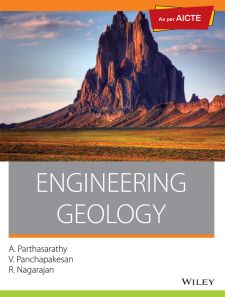Engineering Geology, As per AICTE
ISBN: 9788126509461
532 pages
For more information write to us at: acadmktg@wiley.com

Description
This book contains all the essential ingredients required for the students of Geology and Engineering at Bachelors and Masters levels in addition to all those desirous of pursuing various projects in Earth Sciences. Keeping in view the recent developments in Geology, every chapter has been enriched with detailed illustrations and examples that provide practical understanding to readers. In addition to elucidating on the basic concepts and ideas of geology, the book depicts hazards of various nature and environmental changes. The book is structured in a clear and logical manner to cater the academic and practical requirements of geoscientists and engineers.
Foreword
Preface
About the Authors
Acknowledgements
I Basic Geosciences
1. Geological Concepts and Data
1.1 Introduction
1.2 Solar System
1.3 Earth and Its Origin
2 Geological Processes on the Earth’s Surface
2.1 Introduction
2.2 Weathering and Soil Formation
2.3 Geological Work of Wind
2.4 Geological Work of Running Water
2.5 Glaciers
2.6 Oceans and Seas
3 Materials of the Earth’s Crust
3.1 Introduction
3.2 Mineralogy
3.3 X-Ray Methods of Mineral Identification
3.4 Select Rock-Forming Minerals
3.5 Petrology
4 Disposition of Rocks
4.1 Introduction
4.2 Forms of Intrusive Rocks
4.3 Planar and Linear Features
4.4 Geological Structures
4.5 Geological Maps
II Engineering Geology and Allied Fields
5 Geomorphology and Hydrogeology
5.1 Introduction
5.2 Geomorphology
5.3 Hydrogeology
5.4 Geothermal Springs
6 Natural Hazards and Environment
6.1 Introduction
6.2 Natural Hazards
6.3 Environmental Hazards
7 Clay Mineralogy
7.1 Introduction
7.2 Classification of Clay Minerals
7.3 Clay Mineral Groups
7.4 Crystal Structure of Clay Minerals
7.5 Clay Mineral Properties
7.6 Thermal Methods
7.7 Base Exchange Capacity
7.8 Industrial Applications
7.9 Origin of Clay
7.10 Clay Mineral Equilibria
8 Remote Sensing and Geographic Information System
8.1 Introduction
8.2 Aerial Photographs
8.3 Orbital Satellites
8.4 Spectral Reflectance
8.5 Visual Interpretation of Satellite Image
8.6 Airborne Survey
8.7 Geographical Information System
8.8 Applications
9 Quarrying, Excavation and Drilling
9.1 Introduction
9.2 Surface Investigations
9.3 Sub-Surface Investigations
10 Geophysical Methods
10.1 Introduction
10.2 Resistivity Methods
10.3 Seismic Methods
11 Geotechnical Aspects of Soils
11.1 Introduction
11.2 Soil Investigations
11.3 Soil Engineering Properties
11.4 Soil Classification
III Rock Properties, Behaviour and Applications
12 Geo-Engineering
12.1 Introduction
12.2 Stress and Strain in Rocks
12.3 Intact and In Situ Rocks
12.4 Evaluation for Suitability of Site
12.5 Weathering
12.6 Physical and Engineering Properties
12.7 Discontinuities, Joints and Bedding
13 Engineering Rock Classifications
13.1 Introduction
13.2 Intact Rock Classifications
13.3 Rock Mass Classifications
13.4 Significance of Q-System and RMR Studies
14 Engineering Behaviour of Rocks
14.1 Introduction
14.2 Hard Rocks
14.3 Soft Rocks
14.4 Engineering Properties of Select Rocks
15 Dams and Reservoirs
15.1 Introduction
15.2 Dam Site Investigations and Data Acquisition
15.3 Types of Dams
15.4 Properties of Rocks and Soils of Dam Sites
15.5 Major Criteria for the Selection of Dam Sites
15.6 Failure Risks and Remedial Measures
16 Tunnels and Underground Openings
16.1 Introduction
16.2 Terminology and Prime Requirements for Tunnelling
16.3 Geological and Structural Guidelines
16.4 Tunnelling and Strata Disposition
16.5 Arching and Lining of Tunnels
16.6 Rock Loads and Support System
16.7 Rock Classification – Application to Tunnelling
16.8 An Integrated Approach – Tunnel Geology and Engineering Rock Classification
17 Landslides
17.1 Introduction
17.2 Landslide – Definition and Characteristics
17.3 Lithology, Structure and Stratigraphy
17.4 Classification of Slides
17.5 Failure and Slide Type
17.6 Causes of Failure
17.7 Slope Stability
17.8 General Observations
17.9 Case Studies
18 Rocks in Construction
18.1 Introduction
18.2 Building Stones
18.3 Aggregates
18.4 Foundations
18.5 Grouting
19 Case Studies
19.1 Dams and Reservoirs
19.2 Tunnels
IV State-Wise Indian Geological Set-Up
20 Geology of India
20.1 Introduction
20.2 Physiography of India
20.3 Indian Stratigraphy
Summary
Objective-Type Questions
Review Questions
Answers
Conversion Table
References
Bibliography
List of Permissions
Index

